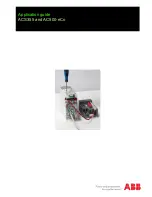
2
6
5
impedance match for amplifier U20 via capacitor C52. U20 supplies 13dB of amplification for the
UHF frequencies with resistor R70 and choke L5 furnishing the necessary power to the hybrid.
From output pin 2 of U20, the amplified signal is brought to the OUTput connector J5 where it will
be fed to the subsequent UHF Bandpass Filter (A2FL1) and eventually to the transmitter’s output.
The second IF signal, present at pin 3 of splitter CP2, functions as the signal level reference for
the output AGC loop. Matching attenuator R34/R35/R36 provides the proper impedance for the
signal brought to pin 1 of 14dB hybrid amplifier U13. Bias is supplied to U13 through resistor R37
and choke L4 with capacitor C31 acting as an RF bypass. Capacitors C32 and C33 in conjunction
with resistor R38 provide coupling and matching from the output of amplifier U13 to the input of
RMS detector U14. As with detector U6 of the input AGC loop, U14 separates the video program
from the IF visual carrier while attenuating the aural components through C35. The demodulated
video signal, found at pin 7 of U14, is amplified by U15A and passed through detector CR4 via
jumper JP2 pins 1 and 2. (Pins 2 and 3 of JP2 are utilized for average digital power detection
only.) The resulting peak of the video signal is transformed into an average dc voltage using filter
CR36/R42 which is then buffered with unity gain amplifier U15B. At the output of divider R43/R45,
the positive detected voltage created by the IF signal at CORRECTOR LOOP J4 meets the
negative POWER REFERENCE voltage supplied to connector J6-8 from the transmitter’s output
power Metering Detector (A7A1) through inverting amplifier U16B. When their associated circuits
are correctly adjusted, these two voltages will be opposite but equal in value, theoretically yielding
0 volts at the output of adder circuit U16A, operational amplifier U17A and integrator U17B. With
the front panel AGC/MANUAL switch PC3S2 depressed (in), this voltage is then sent through pins
8 and 1 of switch S2 and divider R56/R61 to amplifier U18A which controls the attenuation value
of PIN diodes CR9/CR10 and, subsequently, the output power of the transmitter. (With 0V at the
output of switch S1, PIN attenuator CR9/CR10 provides approximately 3dB of signal reduction.
With +15V from S1, the PIN attenuator will furnish almost no resistance and with
15V, diodes
CR9/CR10 will supply about 6dB of signal loss.) If, for some reason the transmitter’s output power
were to drop, the positive voltage at J6-8 would be reduced, making the output of U16B less
negative. The more positive voltage at pin 3 of U16 will force its output positive while the outputs
of U17A and U17B go negative and positive, respectively. The change in level, sent to U18 via
switch S2, forces pin 1 of U18A high reducing the attenuation provided by PIN diodes CR9/CR10.
This reduction in attenuation will be proportional to the power decrease seen at the transmitter’s
output, thereby bringing the transmitter’s power back to its appropriate operating level. In the case
where the transmitter’s output increases above its rated power, the exact opposite happens. The
POWER REFERENCE voltage at J6-8 will increase taking the U16A input negative. The output
from U17A will go positive forcing U17B to send a negative voltage to U18 via switch S2. The
negative voltage from U18A will cause PIN diode attenuator CR9/CR10 to increase resistance,
decreasing the transmitter’s signal level to its proper value.
To defeat the output AGC, the front panel AGC/MANUAL switch must be released (out), placing
a ground on the OUTPUT AGC CONTROL line at pin 10 of J6. This low, applied to pin 6 of switch
S2, causes the incoming AGC voltage at pin 8 of S2 to be removed from pin 1 and connected to
the ground at pins 2, 3. The 0V potential sent to U18A will fix PIN diodes CR9/10 at
3dB, the
center of their attenuation range. Amplifier U18B, which also follows the output of S2 at its input
pin 5, acts as a unity gain buffer forwarding the output AGC voltage to the Exciter’s front panel
AGC meter (A2PC3DS12) and to the RJ45 REMOTE plug (A8J1) on the VIDEO/AUDIO/REMOTE
rear panel.
















































